语言学概论总复习.docx
语言学概论完整版复习资料
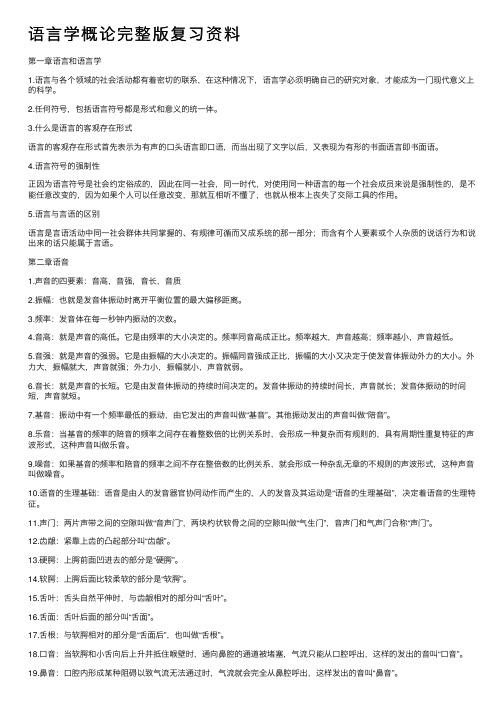
语⾔学概论完整版复习资料第⼀章语⾔和语⾔学1.语⾔与各个领域的社会活动都有着密切的联系,在这种情况下,语⾔学必须明确⾃⼰的研究对象,才能成为⼀门现代意义上的科学。
2.任何符号,包括语⾔符号都是形式和意义的统⼀体。
3.什么是语⾔的客观存在形式语⾔的客观存在形式⾸先表⽰为有声的⼝头语⾔即⼝语,⽽当出现了⽂字以后,⼜表现为有形的书⾯语⾔即书⾯语。
4.语⾔符号的强制性正因为语⾔符号是社会约定俗成的,因此在同⼀社会,同⼀时代,对使⽤同⼀种语⾔的每⼀个社会成员来说是强制性的,是不能任意改变的,因为如果个⼈可以任意改变,那就互相听不懂了,也就从根本上丧失了交际⼯具的作⽤。
5.语⾔与⾔语的区别语⾔是⾔语活动中同⼀社会群体共同掌握的、有规律可循⽽⼜成系统的那⼀部分;⽽含有个⼈要素或个⼈杂质的说话⾏为和说出来的话只能属于⾔语。
第⼆章语⾳1.声⾳的四要素:⾳⾼,⾳强,⾳长,⾳质2.振幅:也就是发⾳体振动时离开平衡位置的最⼤偏移距离。
3.频率:发⾳体在每⼀秒钟内振动的次数。
4.⾳⾼:就是声⾳的⾼低。
它是由频率的⼤⼩决定的。
频率同⾳⾼成正⽐。
频率越⼤,声⾳越⾼;频率越⼩,声⾳越低。
5.⾳强:就是声⾳的强弱。
它是由振幅的⼤⼩决定的。
振幅同⾳强成正⽐,振幅的⼤⼩⼜决定于使发⾳体振动外⼒的⼤⼩。
外⼒⼤,振幅就⼤,声⾳就强;外⼒⼩,振幅就⼩,声⾳就弱。
6.⾳长:就是声⾳的长短。
它是由发⾳体振动的持续时间决定的。
发⾳体振动的持续时间长,声⾳就长;发⾳体振动的时间短,声⾳就短。
7.基⾳:振动中有⼀个频率最低的振动,由它发出的声⾳叫做“基⾳”。
其他振动发出的声⾳叫做“陪⾳”。
8.乐⾳:当基⾳的频率的陪⾳的频率之间存在着整数倍的⽐例关系时,会形成⼀种复杂⽽有规则的,具有周期性重复特征的声波形式,这种声⾳叫做乐⾳。
9.噪⾳:如果基⾳的频率和陪⾳的频率之间不存在整倍数的⽐例关系,就会形成⼀种杂乱⽆章的不规则的声波形式,这种声⾳叫做噪⾳。
10.语⾳的⽣理基础:语⾳是由⼈的发⾳器官协同动作⽽产⽣的,⼈的发⾳及其运动是“语⾳的⽣理基础”,决定着语⾳的⽣理特征。
语言学概论复习题
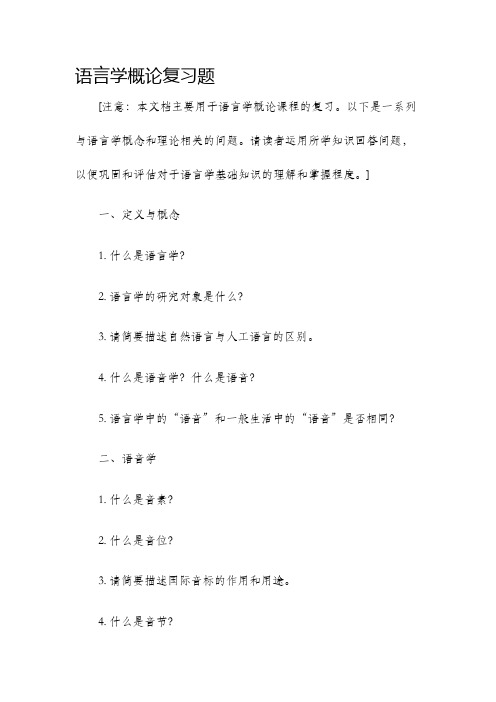
语言学概论复习题
[注意:本文档主要用于语言学概论课程的复习。
以下是一系列与语言学概念和理论相关的问题。
请读者运用所学知识回答问题,以便巩固和评估对于语言学基础知识的理解和掌握程度。
]
一、定义与概念
1. 什么是语言学?
2. 语言学的研究对象是什么?
3. 请简要描述自然语言与人工语言的区别。
4. 什么是语音学?什么是语音?
5. 语言学中的“语音”和一般生活中的“语音”是否相同?
二、语音学
1. 什么是音素?
2. 什么是音位?
3. 请简要描述国际音标的作用和用途。
4. 什么是音节?
5. 请简要描述元音和辅音的区别。
三、形态学
1. 请简要定义“形态学”。
2. 什么是词素?
3. 请举一个例子,解释“单词”和“词”的区别。
4. 请简要说明自由词和实词的区别。
5. 什么是派生?
四、语法学
1. 请简要定义“语法学”。
2. 什么是句子?
3. 什么是短语?
4. 请简要说明短语结构语法(PSG)的原理和应用。
5. 请定义并举例说明主动语态和被动语态的区别。
五、语义学。
(完整word版)语言学概论知识点
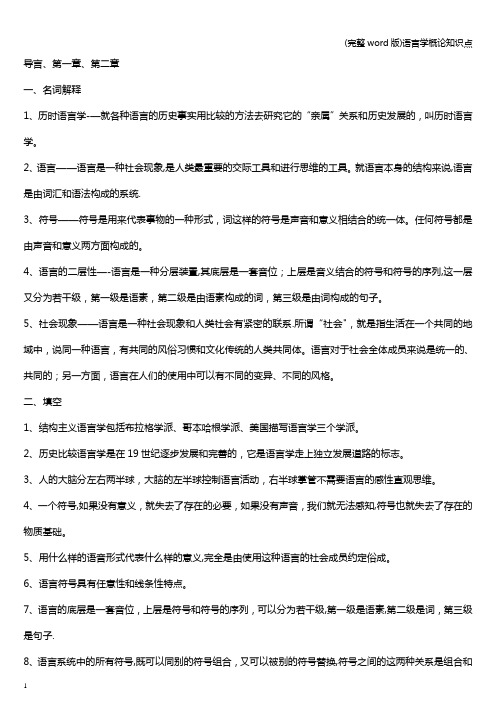
导言、第一章、第二章一、名词解释1、历时语言学-—就各种语言的历史事实用比较的方法去研究它的“亲属”关系和历史发展的,叫历时语言学。
2、语言——语言是一种社会现象,是人类最重要的交际工具和进行思维的工具。
就语言本身的结构来说,语言是由词汇和语法构成的系统.3、符号——符号是用来代表事物的一种形式,词这样的符号是声音和意义相结合的统一体。
任何符号都是由声音和意义两方面构成的。
4、语言的二层性—-语言是一种分层装置,其底层是一套音位;上层是音义结合的符号和符号的序列,这一层又分为若干级,第一级是语素,第二级是由语素构成的词,第三级是由词构成的句子。
5、社会现象——语言是一种社会现象和人类社会有紧密的联系.所谓“社会",就是指生活在一个共同的地域中,说同一种语言,有共同的风俗习惯和文化传统的人类共同体。
语言对于社会全体成员来说是统一的、共同的;另一方面,语言在人们的使用中可以有不同的变异、不同的风格。
二、填空1、结构主义语言学包括布拉格学派、哥本哈根学派、美国描写语言学三个学派。
2、历史比较语言学是在19世纪逐步发展和完善的,它是语言学走上独立发展道路的标志。
3、人的大脑分左右两半球,大脑的左半球控制语言活动,右半球掌管不需要语言的感性直观思维。
4、一个符号,如果没有意义,就失去了存在的必要,如果没有声音,我们就无法感知,符号也就失去了存在的物质基础。
5、用什么样的语音形式代表什么样的意义,完全是由使用这种语言的社会成员约定俗成。
6、语言符号具有任意性和线条性特点。
7、语言的底层是一套音位,上层是符号和符号的序列,可以分为若干级,第一级是语素,第二级是词,第三级是句子.8、语言系统中的所有符号,既可以同别的符号组合,又可以被别的符号替换,符号之间的这两种关系是组合和聚合。
9、组合是指符号与符号相互之间在功能上的联系,聚合是指符号在性质上的归类。
三、判断正误(正确的打钩,错误的打叉)1、文字是人类最重要的交际工具。
语言学概论最新整理.doc
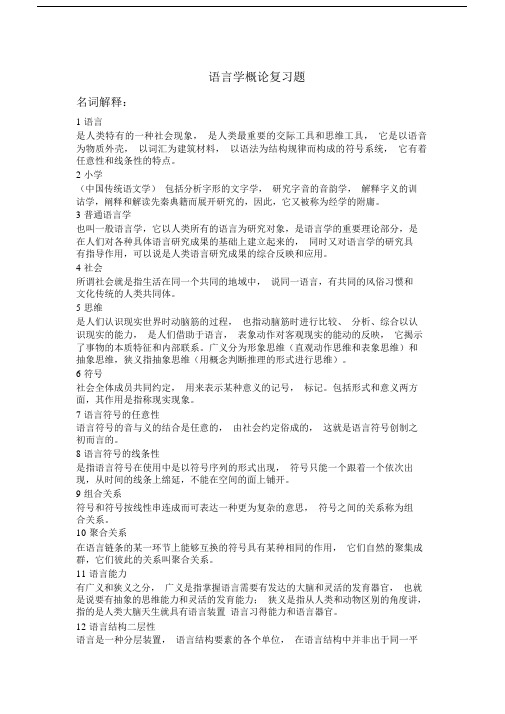
语言学概论复习题名词解释:1语言是人类特有的一种社会现象,是人类最重要的交际工具和思维工具,它是以语音为物质外壳,以词汇为建筑材料,以语法为结构规律而构成的符号系统,它有着任意性和线条性的特点。
2小学(中国传统语文学)包括分析字形的文字学,研究字音的音韵学,解释字义的训诂学,阐释和解读先秦典籍而展开研究的,因此,它又被称为经学的附庸。
3普通语言学也叫一般语言学,它以人类所有的语言为研究对象,是语言学的重要理论部分,是在人们对各种具体语言研究成果的基础上建立起来的,同时又对语言学的研究具有指导作用,可以说是人类语言研究成果的综合反映和应用。
4社会所谓社会就是指生活在同一个共同的地域中,说同一语言,有共同的风俗习惯和文化传统的人类共同体。
5思维是人们认识现实世界时动脑筋的过程,也指动脑筋时进行比较、分析、综合以认识现实的能力,是人们借助于语言,表象动作对客观现实的能动的反映,它揭示了事物的本质特征和内部联系。
广义分为形象思维(直观动作思维和表象思维)和抽象思维,狭义指抽象思维(用概念判断推理的形式进行思维)。
6符号社会全体成员共同约定,用来表示某种意义的记号,标记。
包括形式和意义两方面,其作用是指称现实现象。
7语言符号的任意性语言符号的音与义的结合是任意的,由社会约定俗成的,这就是语言符号创制之初而言的。
8语言符号的线条性是指语言符号在使用中是以符号序列的形式出现,符号只能一个跟着一个依次出现,从时间的线条上绵延,不能在空间的面上铺开。
9组合关系符号和符号按线性串连成而可表达一种更为复杂的意思,符号之间的关系称为组合关系。
10聚合关系在语言链条的某一环节上能够互换的符号具有某种相同的作用,它们自然的聚集成群,它们彼此的关系叫聚合关系。
11语言能力有广义和狭义之分,广义是指掌握语言需要有发达的大脑和灵活的发育器官,也就是说要有抽象的思维能力和灵活的发育能力;狭义是指从人类和动物区别的角度讲,指的是人类大脑天生就具有语言装置语言习得能力和语言器官。
语言学概论复习总结学习资料.doc

《语言学概论》复习资料一、填空题:1.索绪尔开创的语言学派被称为。
2.语言学的研究可以分为三大类:、和。
3.和是语言符号的两个最基本的特点。
4.语音和音系的最小线性单位分别是和。
5.辅音 [p] 和[m] 的相同。
6.根据出现条件是否受环境制约,音位变体可以分为和。
7.根据语素是否可以单独成词,可以把语素分为和。
8.词的五种基本组合关系中,、、和结构分别反映的是陈述和被陈述、支配和被支配、修饰和被修饰、补充和被补充的关系。
9.派生意义产生的途径有和两种方式。
10.语言词汇中除了以外的词构成语言的一般词汇。
二、名词解释:1.元音:2.互补关系:3.语流音变:4、发音方法:5.语法单位的构成关系:6.预设:三、单项选择题:1. 以下哪项不是传统语言学的发源地()。
A. 中国B. 印度C. 希腊罗马D. 埃及2. 从音质角度划分出来的最小的线性的语音单位是()。
A. 音步B. 音素C. 音节D. 音位3. 声音的高低决定于()。
A. 频率大小B. 声波形式C. 气流强弱D. 振动时间4. 下列现象中不属于符号的是()。
A. 旗语B. 炊烟C. 语言D. 狼烟5. 造句时能自由运用的最小的语言单位是()。
A. 语素B. 词C. 音素D. 短语6. 舌面元音中,“前高圆唇”元音是()。
A. [y]B. [i]C. [u]D. [a]7. 国际音标中,“双唇浊塞音”标作()。
A. [f]B. [p]C. [b]D. [m]8. 下列英语单词中含有复辅音的是()。
A.springB.seaC. carD.often9. 英语“ He reads a letter. ”中动词 reads 中的 s 表示的语法意义是()。
b5E2RGbCAPA.性、数、格B.体、人称、时C.数、时、人称D.格、体、时10. 汉字是一种()文字。
A. 表音B. 表意C. 意音D. 图画四、简答题:1.什么是语言符号的任意性?举例说明你对它的理解。
语言学概论复习(完整)
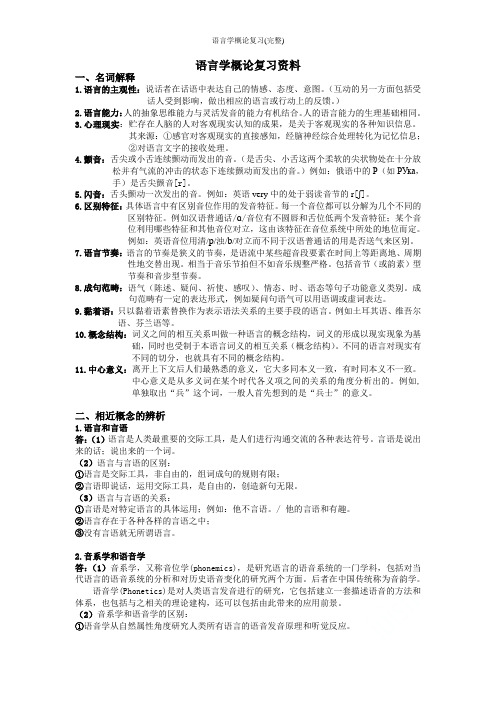
语言学概论复习资料一、名词解释1.语言的主观性:说话者在话语中表达自己的情感、态度、意图。
(互动的另一方面包括受话人受到影响,做出相应的语言或行动上的反馈。
)2.语言能力:人的抽象思维能力与灵活发音的能力有机结合。
人的语言能力的生理基础相同。
3.心理现实:贮存在人脑的人对客观现实认知的成果,是关于客观现实的各种知识信息。
其来源:①感官对客观现实的直接感知,经脑神经综合处理转化为记忆信息;②对语言文字的接收处理。
4.颤音:舌尖或小舌连续颤动而发出的音。
(是舌尖、小舌这两个柔软的尖状物处在十分放松并有气流的冲击的状态下连续颤动而发出的音。
)例如:俄语中的Р(如РУка,手)是舌尖颤音[r]。
5.闪音:舌头颤动一次发出的音。
例如:英语very中的处于弱读音节的r[ʃ]。
6.区别特征:具体语言中有区别音位作用的发音特征。
每一个音位都可以分解为几个不同的区别特征。
例如汉语普通话/ɑ/音位有不圆唇和舌位低两个发音特征;某个音位利用哪些特征和其他音位对立,这由该特征在音位系统中所处的地位而定。
例如:英语音位用清/p/浊/b/对立而不同于汉语普通话的用是否送气来区别。
7.语言节奏:语言的节奏是狭义的节奏,是语流中某些超音段要素在时间上等距离地、周期性地交替出现。
相当于音乐节拍但不如音乐规整严格。
包括音节(或韵素)型节奏和音步型节奏。
8.成句范畴:语气(陈述、疑问、祈使、感叹)、情态、时、语态等句子功能意义类别。
成句范畴有一定的表达形式,例如疑问句语气可以用语调或虚词表达。
9.黏着语:只以黏着语素替换作为表示语法关系的主要手段的语言。
例如土耳其语、维吾尔语、芬兰语等。
10.概念结构:词义之间的相互关系叫做一种语言的概念结构,词义的形成以现实现象为基础,同时也受制于本语言词义的相互关系(概念结构)。
不同的语言对现实有不同的切分,也就具有不同的概念结构。
11.中心意义:离开上下文后人们最熟悉的意义,它大多同本义一致,有时同本义不一致。
语言学概论考试复习资料.docx

语言学概论考试复习资料.docxLanguage is a system of arbitrary,vocal symbols used for human communication. Impoilant f eatures that are typical of the nature of human language: Language is systematic/symbolic/arbitrary/primarily vocal/human specific/used for communication Linguistics is generally defined as the systematic study of language?General functions refer to the particular individual uses of language?Metafunctions refer to the larger, more general purposes underlying language use. Metafunctions of language: ideational/interpersonal/textual functionSeven general functions of language: physiological/phatic/recording/identifying/reasoning/communi catin/pleasure function Sounds arc units which combine to make words or parts of words.Signs,three major types:Icon(We say a sign is an icon when an object and its sign are related to each other by a physical resemblance. eg. a photo that is taken of a video cassette) Indcx(A sign is called an index when an object and its sign are associated to each other by physical proximity.eg. in the case of thunder and lighting, thunder is an index.)Symbol(If a sign and the object it signifies are associated by social convention, the sign is called a symbol.eg, traffic lights, wedding rings, national flags.)The origin of language: creation, evolution, invention Language families: Genetic Classification, Typological Classification Some important distinctions in linguistics: langue and parole, prescriptive and descriptive, synchronic and diachronic, speech and writing, syntagmatic and paradigmatic,competence and performance, functionalism and formalism The diachronic study refers to the description of the historical development of a language?The synchronic study refers to the description of a particular state of a language at a single point of time.Paradigmatic relation refers to oppositions which produce distinct and alternative tcrms(foot as opposed to feet). Syntagmatic relation refers to the relations between units which combine to form sequences?Competence refers to the knowledge that native speakers have of their language as system of abstract fornial relations. Performance refers to what we do when we speak or listen, that is, the infinite varied individual acts of verbal behavior with their irregularities, inconsistencies, and errors?Phonetics is the study of human speech sounds?Phonology is the study of sound patterning?Semantics is the study of meanin g?use of linguistics: pragmatics, anthropological lingustics, psycholinguistics, sociolinguistics, neurolinguistics, applied linguistics, computational linguisticsAll vowels are voiced, as are the following consonants: d,b,g,q,、,six plosives: p,b,t,d,k, g three nasals: m,n, rj eight fricatives: f,v,0, 6,s,z,J, 3Vowels are made by egressive pulmonic airflow through vibrating or constricted vocal folds and through the vocal tract, and the sound is modified in the oral cavity. However, vowels are more difficult than consonants to describe articulatorily? According to Sloat et al (1978:10-11), the primary criteria for the classification of vowels are: (1) the distance between the top of the tongue and the roof of the mouth and (2) the retraction andextension of the tongue. A secondary criterion is the rounding of the lips. 分类:1 分为close/ open / low/ high vowels2 分为vowels with tongue retraction are called back vowels /Vbwels made with the tongue body extended to toward the front of the oral cavity are called front vowels另一种分类:Vowels may be subdivided into monophthongs and diphthongs. 单元音和双元音2.1.3 Characteristics of English Speech Sounds元咅和4甫咅:Like other languages, English has both vowels and consonants. As we have discussed, vowels are produced by shaping the oral cavity through which air from the lungs is allowed to flow more or less freely. Consonants are made by constricting the vocal tract at some point thereby diverting, impeding, or completely shutting off the flow of air in the oral cavity.English has many vowel sounds? According to Roach (1991),there arc seven short vowels、five long vowels,eight diphthongs and five triphtho ngs.eia, ais, oia, sua, auaConsonants arc usually classified according to their place of articulation and manner of articulation. English is said to have twenty-four consonants?音标2.1.4 The Transcription of Sounds音标字母:A phonetic alphabet can represent speech in the fonn of segments, or individual speech sounds like [p], [s] or [m]. 标音法:A phonetic transcription is an economical means for capturing sounds on pape匚国际音标:The best-known system, the InternationalPhonetic Alphabet (IPA), has been developing since 1888. This system of transcription attempts to represent each sound of human speech with a single symbol.The sounds symbols allow us to represent many nuances of articulation. There are two kinds of transcription: narrow transcription and broad tTanscription .严式音标[]A transcription records as many features of an utterance as can be ascertained by the person doing the recording is called a narrow transcription.宽式音标〃A transcription that omits many of the irrelevant and predictable details of pronunciation is called a broad transcription. Phonology is the study of the sound patterns in human language. Thus, the term phonology is used in two ways, either as the study of the sound patterns in language or as the sound patterns of a language?Phoneme is minimal meaningful linguistic unit.(Phoneme is the minimum phonemic unit that is not further analyzablc into smaller units.In Sloat et al's definition, each lexical entry includes, along with information about the semantic and syntactic nature of the morpheme, an underlying representation. The segments of an underlying representation are called phonemes.)(distinctive sounds) However, a phoneme may have its variants. These phonetic variants of a phoneme arc known as allophones.A pair of phonemes is also known as a minimal pair. In other words, when two different fbnns arc identical in every way except for one sound segment that occurs in the same place in the string, the two words are called minimal pairs.区别性特征2.2.3 Distinctive FeaturesEvery language has a limited number of phonological oppositions. In order to find out these oppositions, distinctivefeatures can be use to distinguish one phoneme from another or one group of sounds from another group. Distinctive features are often shown in the form of a binary opposition. The features can be shown either present [+] or absent [-].Tongue Body Features ? The Features Rounded ? The Features High and Back in Consonants ? Manner Features We can also use features such as voicedness, tenseness, and place of articulation to describe a number of speech sounds?语音模式:2.3 Sound PatternsSound patterns refer to the set of sounds that occur in a given language, the pennissible arrangements of these sounds in words, and the processes for adding, deleting, or changing sounds?Sequential Constraints:All languages have constraints on the permitted sequences of phonemes, though different languages have different constraints.However, it is not difficult to show that speakers have knowledge of such sequential rules. Another sequential constraint in English pertains to clusters (one or more consonants) of nasal consonants followed by nonnasal (oral) stops within words. There arc restrictions on the order in which sounds can occur in a given language? The permissible orders arc generally quite limited. The simplest and most natural arrangement is the alternation of consonants and vowels in the pattern ^consonant- vowel- consonant- vowel...11. Every syllable begins with a single consonant and ends with a vowel.4 Another common constraint is that every word must contain at least one vowel-like segment?When two or more sounds never occur in an identical phonemic context or environment, they arc said to be in complementary distribution. Complementary distribution refersto the case in which one of two or more sounds occur in a context to the exclusion of other sound(s), i.e. in a context in which the other sound(s) never occur(s)?即是语位变体:According to Wardhaugh (1977:65), phonetically similar sounds in complementary distribution are allophones of a single phoneme?Although the occurrence of sounds in complementary distribution is a prerequisite to these sounds being allophones of one and the same phoneme, this is not the sole condition □ T he other necessary condition to be met is the criterion of phonetic similarity. The sounds in complementary distribution must be phonetically similar to each other for them to be regarded as allophones of one and the same phoneme. This latter condition is not met in the example of [h] and 〔引,which are subsequently considered to belong to separate phonemes. Suprasegmental Features:Syllable /Stress /Pitch/ Intonation and TonePhonetically, the syllable consists of a center which has little or no obstruction to airflow and which sounds comparatively loud; before and after this center there is greater obstruction to airflow and/or less loud sound? According to Roach (1991:67), a minimum syllable is a single vowel in isolation?Stress is generally defined as syllable prominence? In other words, a syllable that is more prominent than the other syllables in a word or phrase is said to be stressed. In many languages, including English, some syllables within a word are relatively more prominent thanothers.Stress is a conventional label for the overall prominence of certain syllables relative to others within a linguistic system? Itrepresents the total effect of factors such as pitch, loudness, and duration.Some words may have a primary stress and one or more than one secondaiy stresses.However, no word has more than one primary stress. English syllables seem to be stressed by a combination of raised pitch and increased loudness and length.When words are combined into phrases and sentences, one of the syllables receives greater stress than all others? Only one of the vowels in a phrase or sentence receives primary stress. All the other stressed vowels are reduced to secondaiy stress. According to Clark and Yallop (1990:287), patterns of stress are highly important in a language such as English.Pitch is a suprasegmental quality which extends over individual segments and longer stretches of speech. Pitch is the perceived frequency of a sound wave. Perceived pitch is largely determined by the frequency of vibration of the vocal folds, and to some extent by the intensity of the sound? The relationship between pitch and fundamental frequency is nonlinear and varies with the frequency involved?In many languages, some syllables or vowels are produced with a change in pitch, more loudly, and longer than other vowels in the word or sentence. They are referred to as stressed. Pitch patterns are essentially either steady, rising or falling .Intonations refer to the pitch differences that extend over phonetic units larger than the syllable. By means of intonation, syllables arc grouped into phrases, and phrases into sentences? In English a phrase usually has one or two different terminations. The most common phrasal intonation ends on a falling pitch; the other ends on a more or less level pitch?分类:As noted by Sloat et al (1978:76?78), intonation serves several functions in verbal communication. Grouping of Words /Emphasizing Words / Differentiating Meanings单词分组.Grouping of WordsFirst, intonation contours may indicate the possible groupings of words in phrases, resulting in different meanings of these phrases. In the following two phrases, the first one means a boys1 school that is small, while the second means a school for small boys?强调单词.EmDhasizing WordsIntonation may also serve to emphasize a certain word within a phrase or sentence. The first of the following sentences has a neutral intonation contour. The second has higher pitch on one word than would normally be expected. That word therefore takes on special importance in the sentence? Thus, the second sentence means John only kissed Mary. He did not do anything else to her意义区分?Differentiating MeaningsFurthemiore, in English, the same sentence may mean quite different things when spoken with different intonations. For the most part declarative sentences terminate with a falling pitch and questions requiring a yes or no answer terminate on a rising pitch. Exclamations are often characterized by a high pitch throughout.音调:Tone refers to pitch variations .In some languages, the same sequence of segments may have different meanings if uttered at different relative pitches? The function of tone is quite different from that of stress. Tones do not mark the beginning and ending of words, nor do they even indicate to the speaker how many words there are in an utterance.声调语占:Languages that use pitch in this way arc called tone languages?语音语调注册:T one languages with the majority of syllables maintaining the same level or register are called register tone languages ?纯音单音:Register tones and falling and rising tones are called simple tones?声调轮廓:T ones that rise, fall or change direction within a syllabic arc called contour tones.The four characteristics of a word: 1A word is a sound or combination of sounds which we produce voluntarily with our vocal equipment.2A word is symbolic.3Words are part of the large communication system we call language.4Words can help human beings interact culturally with one another.How to identify a word:lFirst, to recognize its series of meaningfully separable sound segments or letters in the stream of speech in the written tcxt.2Sccond, to recognize the accumulated experiences with which its sound segments or letters arc associated.3Third, to recognize its fimetion in a sentence or an utterance as it works grammatically with other words.4Lastly, to relate words to the social and cultural context in which they are uttered so as to figure out the speaker's intention or illocutionary force?A preposition is a word used with the prepositional complement(which is characteristically a noun phrase, a pronoun, a nominal wh?clause, or a nominal-ing clause) to show its grammatical connection with another part of the sentence.A pronoun is a word in place of a noun or a noun phrase? A conjunction is a word that connects parts of sentences or phrases? Anoun is the name of an object, a happening and an idea. A full verb is a word that tells what someone or something is,does,or experience.A morpheme is the smallest linguistic unit that carries grammatical and/or semantic meaning. The different variants of a morpheme arc called allomorphs?Morphemes can be divided into free morphemes and bound morphemes according to whether they can be used independently as free forms or not. If a morpheme can constitute a word by itself it is called a free morpheme. If a morpheme has meaning only when connected with at least another morpheme, it is bound?The best known definition of word is given by Bloomfield, who defines a word as “a minimum free fdrnV\ that is9 the smallest form that can occur by itself. English words can be classified into closed class, open class and two lesser categories and words of unique function. Closed class includes: preposition,pronoun, determiner^ conjunction, modal verb,primary verbA determiner refers to an item which determines the references of a noun phrase in the linguistic or contextual context.Modal verbs like can, could, may, might, must, need, dare, will, would, shall, should .etc. cannot function independently as predicate verbs. They should go with the base fomiPrimary verbs like be, have, do cannot function independently as predicate verb in the clause?Open class includes: Nouns, Full verbsAdjectives,AdverbsA full verb is a word that tells what someone or something is, does, or experiences? Full verbs can be further divided transitive (put, give) and intransitive verbs (arrive)?Speak: either transitive or intransitive Regular full verbs: work, have four morphological forms.Irregular full verbs: a verb like undergo has five, cast has only three whereas the primary verb be has as many as eight.The two lesser categories are numerals 数次(cardinal numerals 基数词and ordinal numerals 序数词)and interjections 感叹词. Numerals are words that denote numbers or the order.Interjections are words or phrases used as a sudden remark usually expressing feelings, such as exclamation, sorrow, surprise, regret There are also a number of words of unique function, like the negative particle not and the infinitive marker to.Open class: we can add new words to these classes? E.g. cybernation(n), stonewall(v), clone(v), biodestnictible(adj), weatherwise(adv) and salewise(adv).Closed class: prepositions, relatives 关系词,auxiliary verb 助动词,the linking verb 系动词/o be, pronouns and other pro-verbs.A pro-form 替代形式is a word or expression used as a substitute for another fbrm.A pro?verb is a verb form like do or do so which is used as the substitute of a verb phrase, usually for the sake of avoiding an undesired repetition in the clause?According to their variability, words can also be classified into variable 易变的and invariable 不变的words.Variable words can take inflectional ending and thus have ordered and regular series (called paradigm) of grammatically different word forms.Invariable words do not take inflectional 曲折变化的endings?English has the least variable words. In modern English, only a few lexical categories, including nouns, verbs, gradable 可分类的adjectives and adverbs, have paradigms 范例as follows: N: book books boy's V: work works working worked Adj/Adv fast faster fastestAccording to where they denote lexical or grammatical meanings, words fall into two categories: lexical words 词V匚词and grammatical words 语法词.①Nouns, pronouns, full verbs, adjectives, adverbs and numerals always denote objects, happenings, ideas, their properties and other lexical meanings and thus are generally labeled as lexical words or content words?②Conversely, conjunctions, prepositions, primary verbs and modal auxiliaries, inteijections and particles denote one grammatical meaning or another and arc thus called grammatical words or functionHowever, lexical words and grammatical words are closely related?The syntactic criteria for assigning words to lexical categories very often rely on specific types of grammatical function words. For example, nouns can be preceded by a definite the or indefinite article a(n), and the function of the article is to indicate what the noun refers to is either more or less specific. Such words present problems of segmentation 分害山different in degree or in kind? These words included 1) the irregular plurals like men, mice, children, oxen, sheep, deer, etc.;(2) the past form and/or -ed participle of certain verbs like went, came, took, cut, etc.; (3) the irregular comparatives and superlatives like better, best, further, furthest.Allomorphs 语素变体:can be phonologically or morphologically conditioned? ed 发咅When the selection of an allomorph is determined by the lexical form of the base word with which it is combined, it is moq?hologically-conditioned. Examples include: irregular plurals: oxen, children, sheep, deer, geese, feet the past form of certain verbs: went,took, bought, cut the -ed participle of certain verbs: gone, taken,bought, cut Morphemes can be divided into free morphemes 自由词素and bound morphemes 黏着词素according to whether they canbe used independently as free forms or not.If a morpheme can constitute a word(free form) by itself, it is called a free morpheme, like room, bottle.standjarge.If a morpheme has meaning only when connected with at least another morpheme, it is bound, like tin- in unlucky and the plural 一s in bags?A bound morpheme is also called an AFFIX in the sense that it is always added to another morpheme.The stem 词干can be a free morpheme?Boy in boys, boyhood,boyish?Affixes can be further divided into prefixes 前缀,suffixes 后缀and infixes 中缀. Prefix可能改变单词意思un?, mono?,mini-,bi?,macro-,也可能只是改变语法意义cn- Most suffixes have two functions: to add some grammatical meanings to the stem -s or change its grammatical categories -ly -fill.一种也不变的:n+ly->n daily, monthlyn+lul->n mouthful, handfulSome affixes Jikc the suffix YC,may denote different lcxical/grammar meanings:Employee; escapee(a person who has escaped);refugee;standeeBound morphemes can be divided into two types according to whether they provide the lexical item to which they are added any further grammatical meaning and/or lexical meaning.①An inflectional morpheme 曲折词素provides further grammatical infbnnation about an existing lexical item. English inflectional morphemes are largely in the form of suffix.② A derivative morpheme 派生词素refers to one that creates an entirely new word? It may take the form of a prefix or a suffix.3.3inflcction and word?fbimationInflection 曲折refers to the process of adding an affix to aword or changing it in some other way according to the rules of the grammar of a language?Compared with other Indo-European languages, Modem English has relatively f^vv inflectional morphemes, including: the plural {s} the third-person singular {s}the -ing participle {ing} the past form and past participle {ed} the comparative {er} the superlative {est}the genetive case {5s} (as in "the girfs doll") the feminine gender {ess} (as in "actress”)CompoundingRefers to the process of conjoining two or more tree morphemes to fomi a new word.Semantic features 语义特征When two or more free morphemes arc combined into a compound, a new meaning arise, which is in most eases no longer a simple combination of the meanings of the component elements.Greenhouse ->not necessarily green in colorOrthographic Matures 平面特征Most compound words are either hyphenated 带有连字符的or completely conjoined 联合的,like ^rass-blacle, grass-plot, grassland and grasshopper.Phonological features 语音特征The stress of compound noun usually falls on the first constituent morpheme?Grammatical features 语法特征Compound words have special internal structures, which are normally unacceptable in free phrases.Normally do not take comparative and superlative fbrms 无比较级牙口最高级?Plural marker always fall on the last component,as in flowerpots, conveyor belts, daughters-in-law and women doctors.Derivation根据词源发展而來3?Conversion转化(词性转化,多半是一个词素的单词)Abbreviation 缩写Clipping (等同于cutting)Blending 组合Back formation 逆构词(onomatopoeia 拟声,象声法)Neolozism 新词(也称new coinage)Borrowing 夕卜来词Analogy and contrast 类比和对比Lexeme 词位:A lexeme is an abstract unit and thus may occur in many different forms in actual spoken or written texts.The verb lexeme speak may take five forms: speak, speaks, speaking, speak, spoken.Homonyms 同形同音异义词:lexical items which sound the same but differ in grammatical and lexical meanings. Collocation 搭配:refers to the acceptable combination between individual lexical items.Four kinds of rules govern or restrict the selection of lexical items allowable to co-occur:Rules of the first kind are logical, which arise from the extra-linguistic world.(break this rule leads to false or contradictoiy utterances) When talk about football, we may expect the occurrence of verbs like garb, rebound, sink and shoot.Rules of the second this kind are semantic, which are generally language-specific.(break this rule produce semantically unacceptable utterances)Dog may take adj. like devoted, intelligent, brave, considerate and lovely.Rules of the third kind are lexical, which apply only to the expressional aspect and so relate to the choice of words or the co-occurrence of lexical items of one category with those of anothe匸We say take a walk instead of make a walk?Rules of the last kind arc grammatical.Abide by,adhere to,remind ...of....restrain fromPhrasal lexemes which have relatively regular lexical meaning and restricted grammatical variation are referred to as IDIOMS. English idioms have two characteristics: (a) semantic unity 语义的统一性and (b) structural stability 结构的稳定性.These two characteristics distinguish an idiom from a free phrase. According to its grammatical functions and internal structure, an idiom may fiinction as a verb、noun、adjective or adverb ?Proverb is often a short sentence that people quote and use to give advice and state some general human life experience and problem?Proverbs can also be one kind of idioms.Constituents arc structural units, i.c. any linguistic form, such as words or word groups.Ultimate constituents are the minimal grammatical elements, of which the sentence is composed?Immediate constituents: After a sentence is cut into constituent elements, the two parts that are yielded are called xx.The advantage of IC analysis(Immediate Constituent Analysis) lies in its function that shows not only linear relationship, but also hierarchical ones?A construction is a relationship between constituents. Constructions arc divided into two types: cndoccntric constructions and exocentric constructions.Endocentric construction is one whose distribution is functionally equivalentto that of one or more of its constituents? A word or a group of words act as a definable center or head. Exocentric construction refers to a group of syntactically related words where none of the words is functionally equivalent to the group as a whole. There is no definable center or head inside the group?“Definable,' here behaves like an attribute in the construction. Endocentric construction can further be divided into two types: subordination and coordination. If only one immediate constituent is of the same form class as the whole construction, it is the subordinating type. If both constituents are of the same form class as the whole construction, it is the coordinating type.A simple sentence is a group of words which expresses a single independent thought.A coordinate sentence or compound sentence is a group of words which expresses two or more connected and coordinate thoughts ?A complex sentence is a group of words which expresses two or more unified thoughts, one of which is the main or principal thought dependent on it one or more subordinate thoughts?Seven basic clause types of English: SV,SVO,SVC,SVA,SVOO,SVOC,SVOA(subject,verb,object,comple ment,adverbial) Declaratives are sentences in which the subject is present and generally precedes the verb.Interrogatives arc sentences that arc fonnally marked in one of two ways: either yes-no interrogatives with the operator placed before the subject or wh-interrogatives with the interrogative wh-clcmcnt positioned initially.Imperatives are sentences which normally have no overt grammatical subject, and whose verb has the base form. Exclamatives are sentences which have an initial phraseintroduced by what or how, usually with subject-verb order. Four classes of discourse functions: Statements are primarily used to convey infonnation, questions are primarily used to seek information of a specific point, directives arc primarily used to instruct somebody to do something, exclamations arc primarily used for expressing the extent to which the speaker feel about or is impressed by something.Assertion, prediction and apology are pragmatic categories that indicate how sentences are used in actual utterances? Five functional categories of clause constituents: subject,verb,/doc/cb6173657.html plement and adverbial.Subject refers to the noun which serves as the doer or agent of the agent.The grammatical subject in English can govern the predicate in terms of person,number,and tense, and can be checked by a tag?qucstion.Thc predicate is what is said about the subject. Object is the non-subjcct argument of a transitive verb. A transitive verb is a verb that can take a direct object and an intransitive verb is one that does not.Category in syntax usually refers to classes and functions.A syntactic category refers to a word, a phrase or a clause that performs a particular grammatical function, such as subject in a sentence. Primary grammatical categories: Parts of speech Secondary grammatical categories:numbcr, gender, tense, mood, case, person,concord,government.Funcional catrgories: subject, predicate, object. Number is a grammatical category for the analysis of such contrasts as singular and plural of certain word classes?Gender demonstrates such contrasts as masculine, feminine and neuter, animate and inanimate,etc. for the analysis of certain word classes?The case category is often used in the。
语言学概论复习(DOC)

语言学概论复习一、填空题1.语言是人类(最重要)的交际工具,文字是最重要的(辅助性)交际工具。
2.我国古代学者为读懂古书而建立的训诂学、文字学、音韵学组成了我国的(传统语言学),通称为(语文学)。
3.(历史比较)语言学的出现,标志着语言学走出传统语文学,成为一门独立的科学。
4.传统语文学一般主要指古代(古印度)、(古希腊)、(古中国)三个地方的语文学,传统语文学的研究对象主要是(书面语)。
5.20世纪以前的语言学被称为(传统语言学)。
6.历史比较语言学的奠基人是丹麦的(拉斯克)、德国的(葆朴)和(格里本)。
7.著名语言学家瑞士的(索绪尔)的著作(《普通语言学教程》)标志着结构主义语言学的诞生。
8.美国结构主义语言学的代表人物是(布龙菲尔德),他的代表著作是(《语言论》)。
9.转换生成语言学的代表人物是(乔姆斯基),他的代表著作是(《句法结构》)。
10.语言学的三大发源地是(古中国)、(古印度)、(古希腊)。
11.在孩子学习语言的独词句阶段,说明孩子已经具备了(言语)能力。
12.“语言学概论”课程内容在语言学学科分类中,属于(普通理论)语言学。
13.1898年中国第一部系统的语法著作是(马建忠)写的(《马氏文通》)。
14.语音四要素是(音质、音强、音高、音长)。
15.声音的高低取决于(发音体的振动频率),声音的轻重强弱取决于(发音体震动的振幅),声音的长短取决于(发音体震动时间的长短)。
16.汉语普通话/P/的区别特征是(双唇、轻音、塞音、不送气)。
17.汉语普通话中/ k /的区别特征是(舌后、轻音、塞音、送气)。
18.音位变体可以分为(条件变体)和(非条件变体)两类。
19.音质音位是以(音素)为材料构成的音位。
非音质音位包括(音高)、(音重)、(音长)三种。
20.音位是能够起(区别意义)作用的最小的语音单位,包括两种类型(音质音位)、(非音辅音的发音方法主要包括包括(阻碍方式、声带是否震动、气流的强弱)等几个方面。
(完整word版)语言学概论总复习

语言学概论总复习绪论部分小学普通语言学具体语言学语言学史中的重要代表人物及作品语言学的三大发源地人类传递信息的五个过程第一章语言的功能1.语言的功能。
2.语言和思维的关系3.思维能力是全人类相同的,语言是各民族不同的。
第二章语言符号任意性线条性二层性组合关系聚合关系1.为什么说语言是一种符号系统?2.秦赵高指鹿为马,但结果鹿还是鹿,马还是马,这是为什么?用语言符号的理论回答3.同样表示“父亲”“母亲”,汉语用“baba mama”,英语用father mother,为什么会有这样的差别?4.什么是语言的结构二层性?用汉语为例加以说明5.说话只能在有限和无限、自由和不自由的矛盾中进行。
6.语言符号的系统性表现在哪些方面?7.人类语言和动物“语言”的本质区别是什么?第三章语音音素音位音位变体自由变体条件变体音质音位非音质音位音位的区别特征语流音变音节1.语音四要素以及之间的关系。
2.请举例说明语音的社会属性。
3.元音和辅音的区别4.元音的音质由哪些方面的音素决定的?举例说明5.元音舌位图的设计原理?6.怎样认识音位和音素的关系?7.举例说明区分、归并音位的原则。
8.怎样认识音位和音位变体的关系?9.音位的系统性表现在哪些方面?请以普通话为例说明.10. 语流音变有哪些具体表现?请结合具体例子理解。
11.举例说明汉语音节结构的特点。
12.按普通话读音给“他天天在书房里画画儿”注上国际音标。
这句话里有几个元音音位?13.判断下列说法的正误,并说明理由。
英语/P/音位和汉语普通话/P/音位不是对等的.第四章一、语法单位;词;语素;单纯词;合成词;词缀;词根;派生词缀;屈折词缀;词类;语法形式;语法意义;形态;语法范畴;语法的递归性;变换分析;屈折语;孤立语;黏着语二、变换下列句子,使其具有句法同义:1. 我打破了杯子;2. 我们找到了小王三、用变换分析法区分句法多义1.关心的是他母亲。
2.虚构的故事吓坏人。
《语言学概论》复习习题.doc
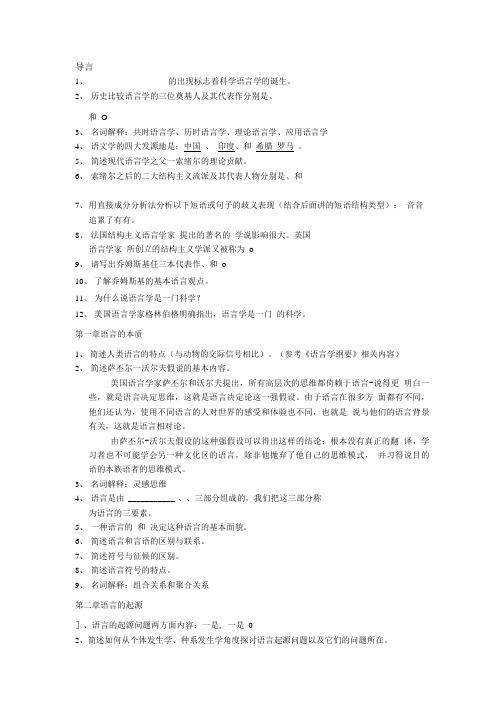
导言1、的出现标志着科学语言学的诞生。
2、历史比较语言学的三位奠基人及其代表作分别是、和O3、名词解释:共时语言学、历时语言学、理论语言学、应用语言学4、语文学的四大发源地是:中国、印度、和希腊罗马。
5、简述现代语言学之父一索绪尔的理论贡献。
6、索绪尔之后的二大结构主义流派及其代表人物分别是、和7、用直接成分分析法分析以下短语或句子的歧义表现(结合后面讲的短语结构类型):音音追累了有有。
8、法国结构主义语言学家提出的著名的学说影响很大。
英国语言学家所创立的结构主义学派又被称为o9、请写出乔姆斯基任三本代表作、和o10、了解乔姆斯基的基本语言观点。
11、为什么说语言学是一门科学?12、美国语言学家格林伯格明确指出,语言学是一门的科学。
第一章语言的本质1、简述人类语言的特点(与动物的交际信号相比)。
(参考《语言学纲要》相关内容)2、简述萨丕尔一沃尔夫假说的基本内容。
美国语言学家萨丕尔和沃尔夫提出,所有高层次的思维都倚赖于语言-说得更明白一些,就是语言决定思维,这就是语言决定论这一强假设。
由于语言在很多方面都有不同,他们还认为,使用不同语言的人对世界的感受和体验也不同,也就是说与他们的语言背景有关,这就是语言相对论。
由萨丕尔-沃尔夫假设的这种强假设可以得出这样的结论:根本没有真正的翻译,学习者也不可能学会另一种文化区的语言,除非他抛弃了他自己的思维模式,并习得说目的语的本族语者的思维模式。
3、名词解释:灵感思维4、语言是由 ___________ 、、三部分组成的,我们把这三部分称为语言的三要素。
5、一种语言的和决定这种语言的基本面貌。
6、简述语言和言语的区别与联系。
7、简述符号与征候的区别。
8、简述语言符号的特点。
9、名词解释:组合关系和聚合关系第二章语言的起源]、语言的起源问题两方面内容:一是, 一是02、简述如何从个体发生学、种系发生学角度探讨语言起源问题以及它们的问题所在。
3、为什么说劳动创造了人类语言?(从语言的产生必须具备下三个条件入手)4、说说语言起源“手势说”的问题所在。
语言学概论复习(全)
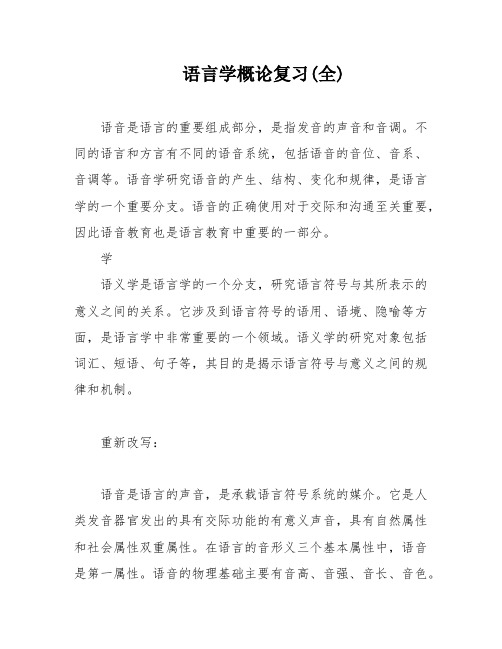
语言学概论复习(全)语音是语言的重要组成部分,是指发音的声音和音调。
不同的语言和方言有不同的语音系统,包括语音的音位、音系、音调等。
语音学研究语音的产生、结构、变化和规律,是语言学的一个重要分支。
语音的正确使用对于交际和沟通至关重要,因此语音教育也是语言教育中重要的一部分。
学语义学是语言学的一个分支,研究语言符号与其所表示的意义之间的关系。
它涉及到语言符号的语用、语境、隐喻等方面,是语言学中非常重要的一个领域。
语义学的研究对象包括词汇、短语、句子等,其目的是揭示语言符号与意义之间的规律和机制。
重新改写:语音是语言的声音,是承载语言符号系统的媒介。
它是人类发音器官发出的具有交际功能的有意义声音,具有自然属性和社会属性双重属性。
在语言的音形义三个基本属性中,语音是第一属性。
语音的物理基础主要有音高、音强、音长、音色。
元音是一种音素,与辅音相对。
元音是在发音过程中由气流通过口腔而不受阻碍发出的音。
汉语拼音方案的字母代表的音属于元音。
元音的不同是由共鸣腔的不同形状造成的。
每个元音的音质由舌位的高低、前后和嘴唇的圆展这三个因素的结合决定。
文白异读指的是一个方言中不少汉字具有两个或多个有文雅/白俗风格区别的语音形式,形成系统的层次。
文读一般是读书音,使用于正式场合,来自权威方言或者民族共同语;白读是口语音,使用于非正式场合,是本方言自己的读音。
历史比较法是根据语音对应关系,比较方言或亲属语言之间的差别来拟测原始“祖语”的方法,是推溯方言或亲属语言的演变过程的有效方法。
音位是从语音的社会属性的角度划分出来的最小的能区别意义的线性单位。
一个音位往往包含几个音素。
音位的作用是区分词或语素的语音形式。
语文学是广义的语言学,研究古代书面语,旨在解读古典文献。
其发源地有古印度、古中国、古希腊-罗马,分别涉及构词法、文字、音韵、训诂、语法、修辞、逻辑等方面。
语言联盟指的是一片地理区域内的不同语言不仅在词汇上有大量的借贷,而且在语音、语法系统的结构格局、结构规则方面也十分相似,但是各语言仍然有相当数量的核心词根彼此不同。
00541《语言学概论》知识点复习(一).docx
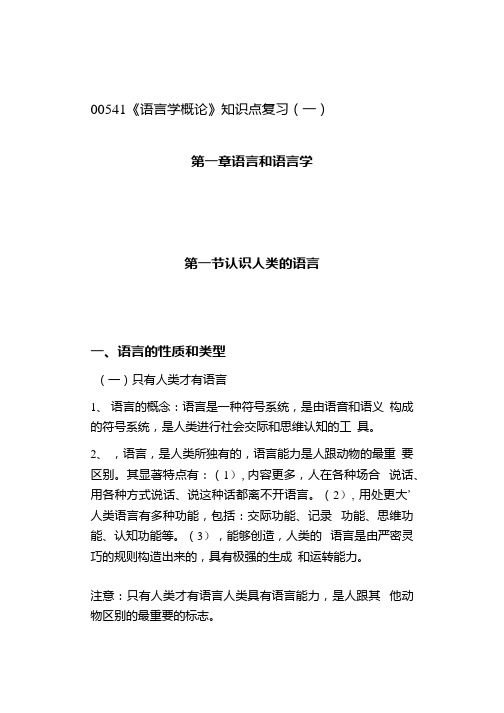
00541《语言学概论》知识点复习(一)第一章语言和语言学第一节认识人类的语言一、语言的性质和类型(一)只有人类才有语言1、语言的概念:语言是一种符号系统,是由语音和语义构成的符号系统,是人类进行社会交际和思维认知的工具。
2、,语言,是人类所独有的,语言能力是人跟动物的最重要区别。
其显著特点有:(1),内容更多,人在各种场合说话、用各种方式说话、说这种话都离不开语言。
(2), 用处更大'人类语言有多种功能,包括:交际功能、记录功能、思维功能、认知功能等。
(3),能够创造,人类的语言是由严密灵巧的规则构造出来的,具有极强的生成和运转能力。
注意:只有人类才有语言人类具有语言能力,是人跟其他动物区别的最重要的标志。
(二)语言和民族、国家的关系1、语言是识别民族和国家的标志一一,相互能够听懂’ (欧洲国家)多数情况下一个民族、一个国家使用同一种语言。
2、语言并非识别民族和国家的标志(欧洲以外的国家)一个民族的成员可以使用不同的语言,不同民族的成员也可以使用同一种语言。
3、西方学界的双重标准——,相互能够听懂’:弱国——用语言识别民族;对,汉语’的看法。
强国一一不用语言识别民族,美国、英国、澳大利亚和加拿大(三)语言特点和语言类型1、不同的语言有自己的特点,各种语言在语音、词汇、语法方面差距显著。
根据语言的特点,把语言进行分类,主要有,语言的谱系分类,和,语言的形态分类'2、从语言的,历时,角度划分,谱系分类是一个层级系统:语系一语族一(语支)一语群一语言一方言一次方言(土语)。
3、形态分类主要分为两种:形态语(综合性语言)和孤立语(分析性语言)——汉语。
(1)形态语(综合语):通过词的形态变化来体现各种结构意义的语言,主要有屈折语(词的形态变化丰富,如德语、俄语)、黏着语(词的形态变化为前后词缀, 如维吾尔语、日语)(2)孤立语(分析语)——汉语:语法手段无需谓词词形变化表现,时、体、态’;无需名词词形变化的,性、数、格',突出语序和虚词;词类与句法成分不对应。
《语言学概论》期末复习网上活动文本.docx
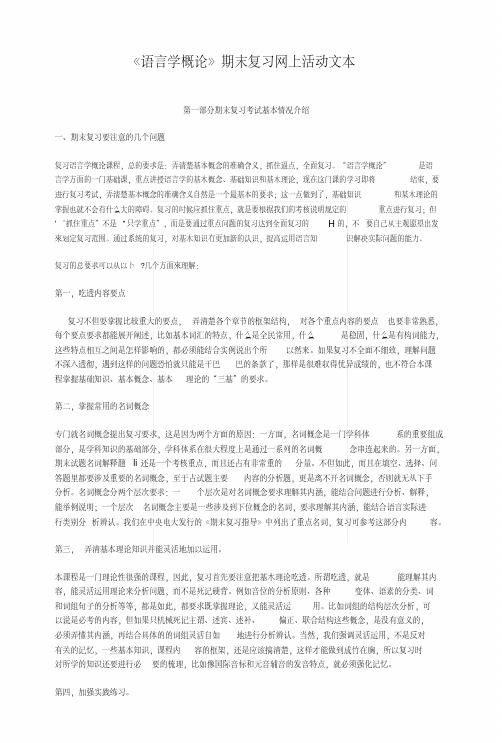
《语言学概论》期末复习网上活动文本第一部分期末复习考试基本情况介绍一、期末复习要注意的几个问题复习语言学概论课程,总的要求是:弄清楚基本概念的准确含义,抓住逼点,全面复习。
“语言学概论”是语言学方面的一门基础课,重点讲授语言学的基木概念、基础知识和基木理论,现在这门课的学习即将结束,要进行复习考试,弄淸楚基本概念的准确含义自然是一个最基本的要求;这一点做到了,基础知识和某木理论的掌握也就不会有什么大的障碍。
复习的吋候应抓住重点,就是要根据我们的考核说明规定的重点进行复习;但'‘抓住重点”不是"只学重点”,而是要通过重点问题的复习达到全面复习的H的,不要自己从主观愿望出发來划定复习范围。
通过系统的复习,对基木知识冇更加新的认识,捉高运用语言知识解决实际问题的能力。
复习的总要求可以从以卜?几个方面來理解:第一,吃透内容要点复习不但耍掌握比较重大的要点,弄清楚各个章节的框架结构,对各个重点内容的要点也要非常熟悉,每个要点要求都能展开阐述,比如基本词汇的特点,什么是全民常用,什么是稳固,什么是有构词能力,这些特点相互之间是怎样影响的,都必须能结合实例说出个所以然来。
如果复习不全面不细致,理解问题不深入透彻,遇到这样的问题恐怕就只能是干巴巴的条款了,那样是很难収得优异成绩的,也不符合本课程掌握基础知识、基本概念、基本理论的“三基”的要求。
第二,掌握常用的名词概念专门就名词概念提出复习要求,这是因为两个方面的原因:一方面,名词概念是一门学科体系的重要组成部分,是学科知识的基础部分,学科体系在很大程度上是通过一系列的名词概念串连起来的。
另一方面,期末试题名词解释题li还是一个考核重点,而且还占有非常重的分量。
不但如此,而且在填空、选择、问答题里都要涉及重要的名词概念,至于占试题主要内容的分析题,更是离不开名词概念,否则就无从下手分析。
名词概念分两个层次要求:一个层次是对名词概念要求理解其内涵,能结合问题进行分析、解释,能举例说明;一个层次名词概念主要是一些涉及到下位概念的名词,要求理解其内涵,能结合语言实际进行类别分析辨认。
- 1、下载文档前请自行甄别文档内容的完整性,平台不提供额外的编辑、内容补充、找答案等附加服务。
- 2、"仅部分预览"的文档,不可在线预览部分如存在完整性等问题,可反馈申请退款(可完整预览的文档不适用该条件!)。
- 3、如文档侵犯您的权益,请联系客服反馈,我们会尽快为您处理(人工客服工作时间:9:00-18:30)。
语言学概论总复习
绪论部分
小学普通语言学具体语言学
语言学史中的重要代表人物及作品
语言学的三大发源地人类传递信息的五个过程
第一章语言的功能
1・语言的功能。
2.语言和思维的关系
3.思维能力是全人类相同的,语言是各民族不同的。
第二章
语言符号任意性线条性二层性组合关系聚合关系
1.为什么说语言是一种符号系统?
2.秦赵高指鹿为马,但结果鹿还是鹿,马还是马,这是为什么?用语言符号的理论冋答
3.同样表示"父亲”"母亲”,汉语用u baba mama v,英语用father mother, 为什么会有这样的差别?
4•什么是语言的结构二层性?用汉语为例加以说明
5.说话只能在有限和无限、自由和不自由的矛盾中进行。
6.语言符号的系统性表现在哪些方面?
7•人类语言和动物“语言”的本质区别是什么?
第三章
语音音素音位音位变体自由变体条件变体音质音位
非咅质咅位咅位的区别特征语流咅变咅节
1•语音四要素以及之间的关系。
2.请举例说明语音的社会属性。
3.元音和辅音的区别
4.元音的音质由哪些方面的音素决定的?举例说明
5•元咅舌位图的设计原理?
6.怎样认识音位和音素的关系?
7 •举例说明区分、归并音位的原则。
8.怎样认识音位和音位变体的关系?
9.音位的系统性表现在哪些方面?请以普通话为例说明.
10.语流咅变有哪些具体表现?请结合具体例子理解。
11.举例说明汉语音节结构的特点。
12.按普通话读音给“他天天在书房里画画儿”注上国际音标。
这句话里有儿个元音音
位?
13•判断下列说法的正误,并说明理由。
英语/P/咅位和汉语普通话/ P /咅位不是对等的.
第四章
语法单位;词;语素;单纯词;合成词;词缀;词根;派生词缀;屈折词缀;词类;语法形式;语法意义;形态;语法范畴;语法的递归性;变换分析;屈折语; 孤立语;黏着语
二、变换下列句子,使其具有句法同义:
1.我打破了杯子;
2.我们找到了小王
三、用变换分析法区分句法多义
1•关心的是他母亲。
2.虚构的故事吓坏人。
3 •三个学校的老师。
4.非洲语言研究
5.鸡不吃了
6.非常热爱祖国和人民的英雄
7.反对他的意见
&我们要学习文件
9 •咬死了猎人的狗。
10.我在火车上写字。
11•他来班里才几天,好些同学都不认识。
四、用变换法辨析下列结构的差别
在黑板上写字;在火车上写字;在教室里写字
五、分析下列语素的结构
老师小鸟儿unhappily workers
六、问答及论述
1.举例说明常见的语法范畴。
2.举例说明语法结构的“普遍特征”。
3.如何区别派生词缀和屈折词缀?
4.举例说明形态的儿种主要形式?
5.语言的形态学分类,每一类的主要特点和代表语言
第五章
基本词汇一般词汇同义词反义词多义词同音词本义派生意义中心意义语义角色蕴含预设言内意外
1•分析词义的概括性
2.同义和反义的辩证关系
3.词义组合的语义条件
4.结合实例分析语义角色和句法成分的关系
5.设计不同的语境,消除歧义。
妈妈的鞋没做好。
那个老人谁都可以接待。
我特别喜欢煎鸡蛋。
6.分析下列对话中的言内意外现象。
(1)甲:你有什么了不起,能把我吃了。
乙:不能,我是回民。
(2)儿子:妈妈,我出去玩一会儿吧。
妈妈:明天就要考试了。
7.分析下列词义的引申方式(5分)
①铁窗:本义是安有铁栅栏的窗户,派生义指监狱。
②天堂:某些宗教指人死后灵魂居住的快乐的地方,派生义指幸福美好的生活环境。
③矛盾:本义指用于进攻和防守的两种兵器,派生义泛指对立事物互相排斥。
④泰山:木义指山东的一座山,派牛义指岳父。
⑤红领巾:本义指红色的领巾,派生义指少先队员。
第六章
文字自源文字他源文字书面语
1.文字的基本性质
2.文字的产牛
3•共吋文字系统的分类
4.文字与语言的关系
第七章
社会方言、地域方言、亲属语言、谱系分类语言演变的原因。
语言演变的特点。
比较社会方言和地域方言的异同。
第八章
借词语言联盟语言替换底层自愿替换被迫替换文白异读洋泾浜混合语世界语
1.分析语言接触的主要类型。
2•语言替换的社会原因。
3•语言替换的过程。
4.哪一种方言会成为基础语言取决于什么?
第九章
语音演变规律性的特点。
语法的演变表现在哪些方面?
词义演变的原因。
词义演变的方式和途径。
词汇的演变。
